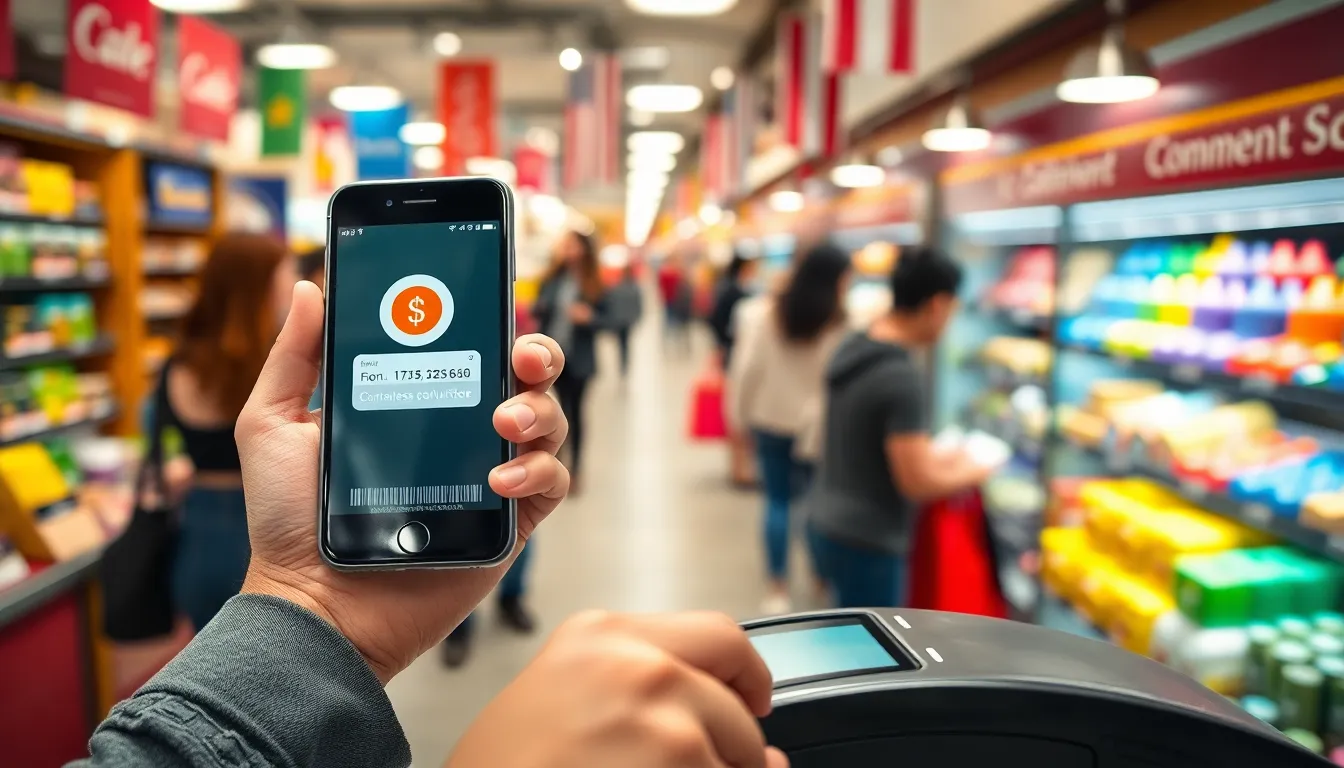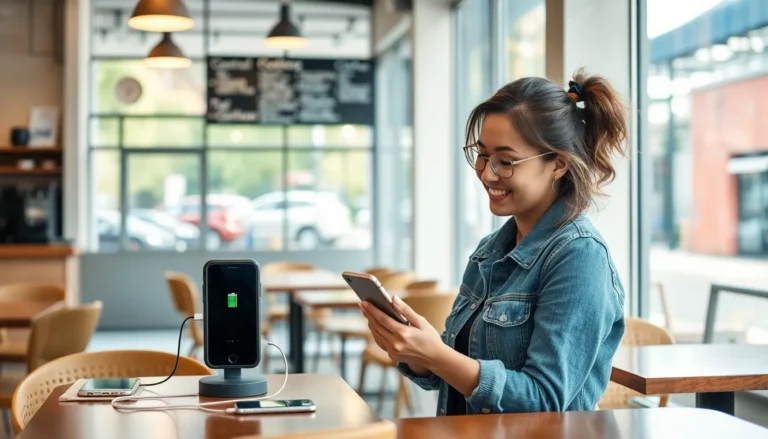Table of Contents
ToggleIn a world where carrying cash feels like a relic of the past, mobile payment solutions have swooped in like a superhero, saving the day for tech-savvy consumers. Imagine a life where you can pay for your morning coffee with just a tap on your phone, all while avoiding the dreaded wallet rummage. It’s not just convenient; it’s practically magic!
As businesses adapt to this digital age, they’re discovering that mobile payments aren’t just a trend—they’re a lifeline. With the rise of contactless payments, the days of fumbling with coins are over. Instead, customers can breeze through transactions, leaving behind the chaos of traditional payment methods. So, whether you’re a small business owner or a consumer looking to simplify your life, embracing mobile payment solutions might just be the best decision you make this year.
Overview of Mobile Payment Solutions
Mobile payment solutions encompass various digital methods that enable consumers to conduct transactions using their smartphones or other mobile devices. These solutions range from mobile wallets to in-app payments and QR codes, facilitating seamless purchases for users. Users can link their bank accounts, credit cards, or debit cards to mobile payment apps, ensuring quick and secure transactions.
Businesses increasingly adopt mobile payment solutions to enhance customer experience and streamline sales processes. For example, coffee shops allow customers to pay with their phones, eliminating the need for cash or cards. Innovators in the industry, such as Apple Pay, Google Pay, and Samsung Pay, continuously improve these platforms, offering users added security and convenience.
Security features play a significant role in mobile payment solutions. Encryption technology, tokenization, and biometric authentication, such as fingerprint or facial recognition, safeguard sensitive data during transactions. Users can trust that their financial information remains protected.
Mobile payment solutions offer various benefits to both consumers and businesses. Consumers appreciate the speed and efficiency these methods provide. Businesses often experience increased transaction speed and reduced operational costs associated with cash handling.
As mobile payment adoption increases, businesses that implement these solutions position themselves to meet evolving consumer preferences. This trend indicates that mobile payments are set to become a standard component of everyday transactions. As such, staying updated on mobile payment trends remains essential for organizations aiming to thrive in a competitive market.
Types of Mobile Payment Solutions

Mobile payment solutions come in various forms, each designed to enhance convenience and security. Understanding these options helps users choose the best method for their transactions.
Digital Wallets
Digital wallets store user payment information securely. Popular examples include Apple Pay, Google Pay, and PayPal. Users link their credit, debit, or bank accounts to these apps for quick access. Transactions occur via NFC technology or QR codes, enabling a smooth checkout process. Digital wallets also prioritize security with encryption and biometric authentication, contributing to user confidence in making purchases. As adoption grows, businesses accepting digital wallets can engage tech-savvy customers effectively.
Contactless Payments
Contactless payments use near-field communication (NFC) technology to facilitate transactions. With a simple tap of a smartphone or contactless card, customers complete purchases quickly and securely. Retailers have increasingly adopted this method, reducing checkout times and queues. Many credit and debit cards now feature contactless capabilities, making them widely accessible. Enhanced security measures, such as tokenization and encryption, protect users during transactions. The popularity of contactless payments reflects consumers’ desire for speed and efficiency, particularly in everyday shopping.
In-App Payments
In-app payments integrate directly within mobile applications, streamlining the purchase process. Users can buy products or services without leaving the app, improving user experience. Popular among e-commerce and service-based apps, this solution allows seamless transactions with stored payment information. Developers prioritize security in processing these payments, employing encryption and secure servers. The ease of in-app transactions encourages repeat purchases, making it a valuable tool for businesses. As mobile commerce expands, in-app payments become an essential feature for increasing customer satisfaction.
Benefits of Mobile Payment Solutions
Mobile payment solutions provide numerous advantages that modern consumers and businesses appreciate. Two critical benefits are convenience and speed, along with enhanced security features.
Convenience and Speed
Mobile payments significantly streamline transaction processes for users. They can buy coffee or groceries quickly with just a tap on their smartphones. Consumers appreciate not needing to carry cash or cards. Businesses benefit from shorter checkout times, enhancing customer satisfaction. Many users opt for mobile wallets, which allow for easy payment options linked to bank accounts or credit cards. This efficiency encourages repeat purchases and fosters consumer loyalty.
Enhanced Security Features
Security plays a vital role in the adoption of mobile payment solutions. Encryption technology protects sensitive data during transactions. Tokenization replaces actual card details with unique identifiers, adding an extra layer of security. Biometric authentication, such as fingerprints or facial recognition, ensures that only authorized users can complete transactions. Studies indicate that these advanced security measures make consumers feel safer about their financial information. With these features, customers can trust that their data remains protected, further driving the popularity of mobile payment solutions.
Challenges in Adoption
Mobile payment solutions face several challenges that hinder widespread acceptance. These obstacles include technical barriers and consumer trust issues.
Technical Barriers
Implementing mobile payment solutions often requires robust infrastructure. Businesses may encounter difficulties if their current systems lack compatibility with new technologies. Network connectivity issues can also disrupt transactions, leading to consumer frustration. Additionally, small businesses may struggle with the costs associated with upgrading equipment. A lack of technical knowledge among staff poses another challenge, as understanding mobile payment processes becomes crucial for successful implementation.
Consumer Trust Issues
Consumer trust remains a significant barrier to mobile payment adoption. Users worry about the security of their personal and financial information. Incidents of data breaches raise concerns about the safety of mobile payment transactions. Educating consumers on encryption and security measures is essential for addressing these fears. Without trust, even the most convenient solutions may face resistance in the marketplace. Users require assurances that their sensitive data is protected before fully embracing mobile payments.
Future Trends in Mobile Payment Solutions
The landscape of mobile payments continues to evolve with emerging technologies driving significant changes. Innovations in blockchain and cryptocurrency are reshaping transaction methods, enabling faster and more secure payments.
Blockchain and Cryptocurrency Integration
Blockchain technology enhances transparency and security in transactions. It allows for direct peer-to-peer payments without relying on intermediaries, reducing transaction fees. Additionally, cryptocurrencies like Bitcoin and Ethereum offer users alternative payment options, appealing to tech-savvy consumers. Businesses adopting these digital currencies can attract a broader customer base, positioning themselves at the forefront of innovation. As regulatory frameworks improve, more organizations may embrace blockchain and cryptocurrency, further integrating these technologies into everyday payment solutions.
Growth of Contactless Technologies
Contactless payment methods are gaining traction among consumers, driven by their convenience and safety. NFC technology enables quick transactions by simply tapping devices at payment terminals. Retailers increasingly implement contactless systems to enhance the shopping experience and reduce wait times for customers. The COVID-19 pandemic accelerated this trend, as many shoppers preferred minimal contact during transactions. Shifts in consumer behavior highlight the demand for faster alternatives, ensuring the growth of contactless technologies remains prominent in the mobile payment landscape.
Mobile payment solutions are transforming the way consumers and businesses approach transactions. With their convenience speed and enhanced security features they’re becoming indispensable in today’s fast-paced world. As technology continues to evolve the integration of innovations like blockchain and contactless payments will further streamline the user experience.
Businesses that embrace these solutions position themselves to meet the growing demand for efficient payment methods. By prioritizing security and staying informed about emerging trends organizations can foster consumer trust and encourage widespread adoption. The future of mobile payments looks bright and it’s clear that these solutions are here to stay.







